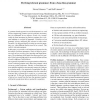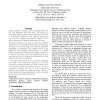ICSM
2003
IEEE
14 years 5 months ago
2003
IEEE
A grammar-based approach to tool development in re- and reverse engineering promises precise structure awareness, but it is problematic in two respects. Firstly, it is a considera...
ICSM
2003
IEEE
14 years 5 months ago
2003
IEEE
Function point analysis is a well known established method to estimate the size of software systems and software projects. However, because it is based on functional documentation...
ICSM
2003
IEEE
14 years 5 months ago
2003
IEEE
Software systems no longer evolve as separate entities but are also integrated with each other. The purpose of integrating software systems can be to increase user-value or to dec...
ICSM
2003
IEEE
14 years 5 months ago
2003
IEEE
The paper reports on a method for software risk assessments that takes into account “primary facts” and “secondary facts”. Primary facts are those obtained through automat...
ICSM
2003
IEEE
14 years 5 months ago
2003
IEEE
As systems evolve, they become harder to understand because the implementation of concepts (e.g. business rules) becomes less coherent. To preserve source code comprehensibility, ...
ICSM
2003
IEEE
14 years 5 months ago
2003
IEEE
The world of software development has rapidly changed in the last few years due to the adoption of component-based technologies. The classical software configuration management, ...
ICSM
2003
IEEE
14 years 5 months ago
2003
IEEE
Software maintainers and auditors would benefit from a tool to help them focus their attention on functions that are likely to be the source of security vulnerabilities. However,...
ICSM
2003
IEEE
14 years 5 months ago
2003
IEEE
The use of product lines is recognized as beneficial in promoting and structuring both component and architecture reuse throughout an organization. While the business practices of...
ICSM
2003
IEEE
14 years 5 months ago
2003
IEEE
Version control and bug tracking systems contain large amounts of historical information that can give deep insight into the evolution of a software project. Unfortunately, these ...
ICSM
2003
IEEE
14 years 5 months ago
2003
IEEE
The distributed development and maintenance paradigm for component delivery is fraught with problems. One wants a relationship between developers and clients that is autonomous an...



